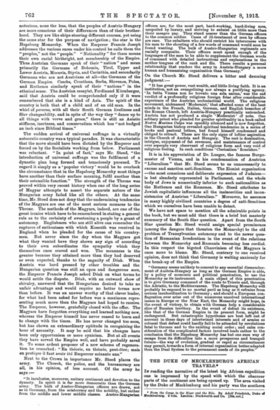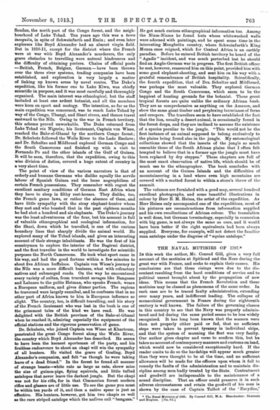THE DUKE OF MECKLENBURG'S AFRICAN TRAVELS.*
IN reading the narrative of the latest big African expedition one is impressed by the speed with which the obscurer parts of the continent are being opened up. The area visited by the Duke of Mecklenburg and his party was the southern
Soudan, the north part of the Congo forest, and the neighbourhood of Lake Tchad. Ten years ago this was a terra incognita, in spite of Schweinfurth and Emin ; and even later explorers like Boyd Alexander had an almost virgin field. But in 1910-11, except for the district where the French were at war with Boyd Alexander's murderers, the only grave obstacles to travelling were natural hindrances and the difficulty of obtaining porters. Chains of official posts --British, French, Belgian, German— have been thrown over the three river systems, trading companies have been established, and exploration is very largely a matter of linking up known areas by novel routes. The Duke's expedition, like his former one to Lake Kiwu, was chiefly scientific in purpose, and it was most carefully and thoroughly organized. The main interest was ethnological, but the staff included at least one ardent botanist, and all the members were keen on sport and zoology. The intention, so far as the main expedition was concerned, was to reach Lake Tchad by way of the Congo, Ubangi, and Shari rivers, and thence travel eastward to the Nile. Owing to the war in French territory, this scheme proved unworkable. The Duke returned from Lake Tchad via Nigeria; his lieutenant, Captain von Wiese, reached the Bahr-el-G-hazal by the northern Congo forest ; Dr. Schubotz followed the Welle River to the Lado Enclave; and Dr. Schultze and Mildbraed explored German Congo and the South Cameroons and finished up with a visit to Fernando Po and the other islands of the Gulf of Guinea. It will be seen, therefore, that the expedition, owing to this wise division of duties, covered a huge extent of country in a very short time.
The point of view of the various narrators is that of orderly and humane Germans who dislike equally the servile labour of Spanish Guinea and the loose negrophilism of certain French possessions. They remember with regret the excellent sanitary conditions of German East Africa when they have to sleep in filthy rest-houses. They dislike, too, the French game laws, or rather the absence of them, and have little sympathy with the stray elephant-hunter whom they met and who boasted that in the past eighteen months he had shot a hundred and six elephants. The Duke's journey was the least adventurous of the four, but his account is full of valuable ethnographical and zoological information, for the Shari, down which he travelled, is one of the curious boundary lines that sharply divide the animal world. He explored many of the Tchad islands, and gives an interesting account of their strange inhabitants. He was the first of his countrymen to explore the interior of the Bagirrni district, and the first traveller in the world to investigate for scientific purposes the North Cameroons. He took what sport came in his way, and had the good fortune within a few minutes to shoot five African buffaloes. Captain von Wiese's journey to the Nile was a more difficult business, what with refractory natives and submerged roads. On the way he encountered every variety of sultan, from truculent savages like Bangasse and Labassu to the polite Hetman, who speaks French, wears a European uniform, and gives dinner parties. The regions he traversed were largely cannibal, and he confesses that in no other part of Africa known to him is European influence so slight. The country, too, is difficult travelling, and his story of the French lieutenant who was lost in the bush is one of the grimmest tales of the kind we have read. He was delighted with the British province of the Bahr-el-Ghazal when he reached it, admiring especially the equipment of the official stations and the rigorous preservation of game.
Dr. Schnbotz, who joined Captain von Wiese at Khartoum, penetrated the great Congo forest along the Welle River, the country which Boyd Alexander has described. He seems to have been the keenest sportsman of the party, and his fruitless endeavours to shoot an okapi will win the sympathy of all hunters. He visited the grave of Gosling, Boyd Alexander's companion, and felt "as though he were taking leave of a dead friend." In the forest he found all manner of strange beasts—white rats as large as cats, shrew mice the size of guinea-pigs, flying squirrels, and little tufted antelopes that never leave the darkest jungle. But the okapi was not for his rifle, for in that Cimmerian forest modern rifles and glasses are of little use. To see the game you must be within ten yards of it, and then a native spear is just as effective. His hunters, however, got him two okapis as well as the rare striped antelope which the natives call " banga.na."
He got much curious ethnographical information too. Among the Niam-Niams he found huts whose whitewashed walls were adorned with paintings, and he spent some time in the interesting Mangbettu country, where Schweinfurth's King Munza once reigned, which for Central Africa is an earthly paradise. Before he entered British territory be heard of the " Agadir " incident, and was much perturbed lest he should find an Anglo-German war in progress. The first British officer he met, however, reassured him on this point, provided him with some good elephant-shooting, and sent him on his way with a grateful remembrance of British hospitality. Scientifically, the fourth expedition, that of Drs. Schultze and Mildbraed, was perhaps the most valuable. They explored German Congo and the South Cameroons, which seem to be the happiest of hunting grounds for the botanist. These great tropical forests are quite unlike the ordinary African bush. They are as comprehensive as anything on the Amazon, and show the same giant timber and perplexing luxuriance of ferns and creepers. The travellers seem to have established the fact that the lion, usually a desert animal, is occasionally found in the forest deeps, and they are inclined to assume the existence of a species peculiar to the jungle. "This would not be the first instance of an animal supposed to belong exclusively to the plains being found also in the jungle. My entomological collections showed that the insects of the jungle so much resemble those of the South African plains that I often felt tempted to believe that in a former age the jungle must have been replaced by dry steppes." These chapters are full of the most exact observation of native life, which should be of much use to the ethnographer. The book concludes with an account of the Guinea Islands and the difficulties of mountaineering in a land where even high mountains are covered with a matted forest to within a stone's throw of the summit.
The volumes are furnished with a good map, several hundred excellent photographs, and some beautiful illustrations in colour by Herr E. M. Heims, the artist of the expedition. As Herr Heims only accompanied one of the expeditions, most of his pictures are reconstructions from information supplied and his own recollections of African colour. The translation is well done, but German terminology, especially in connexion with big game, is not always the same as ours, and it would have been better if the right equivalents had been always supplied. Everyone, for example, will not detect the familiar roan antelope under the disguise of "equine antelope."



















































 Previous page
Previous page